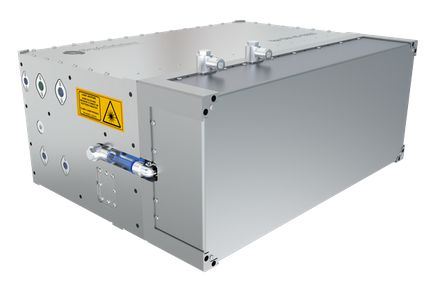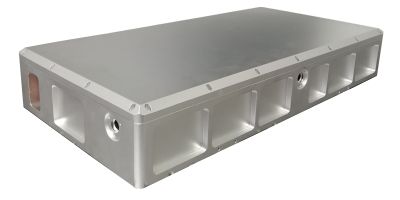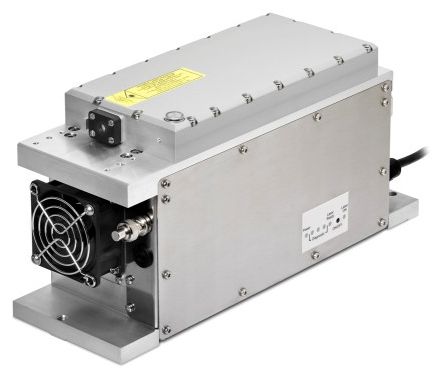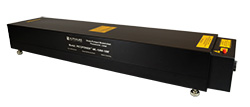picosecond lasers (original) (raw)
Definition: lasers emitting pulses with picosecond durations
Alternative term: ultrafast lasers
Categories:  laser devices and laser physics,
laser devices and laser physics,  light pulses
light pulses
-
- mode-locked lasers
* picosecond lasers
* picosecond diode lasers
* femtosecond lasers
* mode-locked diode lasers
* mode-locked fiber lasers
- mode-locked lasers
Related: mode-locked lasersmode lockingultrafast lasersfemtosecond lasersultrashort pulsespicosecond diode lasersnanosecond laserssolid-state lasersmode-locked fiber lasers
Page views in 12 months: 2687
DOI: 10.61835/6kj Cite the article: BibTex BibLaTex plain textHTML Link to this page! LinkedIn
Content quality and neutrality are maintained according to our editorial policy.
📦 For purchasing picosecond lasers, use the RP Photonics Buyer's Guide — an expert-curated directory for finding all relevant suppliers, which also offers advanced purchasing assistance.
Contents
Applications of Picosecond Lasers
Summary:
A picosecond laser is a type of ultrafast laser that emits light pulses with durations in the range of picoseconds (1 ps = 10−12 s). This article explains the main technologies for generating such pulses, including mode-locked solid-state, fiber, and diode lasers, as well as gain-switched laser diodes and Q-switched microchip lasers.
Key applications are discussed in detail, particularly in the field of laser material processing, where the short pulse duration minimizes detrimental thermal effects, enabling high-quality laser micromachining. Other important applications include medical treatments like tattoo removal, OPO pumping, scientific measurements, and optical fiber communications.
(This summary was generated with AI based on the article content and has been reviewed by the article’s author.)
What are Picosecond Lasers?
A picosecond laser is a laser which emits optical pulses with a duration between 1 ps and (usually) some tens of picoseconds. It thus also belongs to the category of ultrafast lasers or ultrashort pulse lasers.
Sometimes, other laser-based sources for picosecond pulses — for example synchronously pumped OPOs — are also called picosecond lasers, even if they are strictly speaking no lasers.
A variety of laser types can generate picosecond pulses, with other performance parameters varying in wide ranges:
- The most common sources are actively or passively mode-locked solid-state bulk lasers. These can provide very clean (transform-limited and low-noise) ultrashort pulses with pulse repetition rates varying from a few megahertz to more than 100 GHz. For example, a passively mode-locked Nd:YAG or vanadate laser can easily generate e.g. 10-ps pulses with several watts of output power, and thin-disk lasers can generate many tens of watts in shorter pulses.
- Mode-locked fiber lasers can also cover a wide range of repetition rates from a few megahertz up to more than 100 GHz (with harmonic mode locking). Particularly with MOPA or MOFA systems, very high average output powers are possible. The pulse quality from such sources varies; for example, the pulses may or may not be close to bandwidth-limited.
- Lower repetition rates are possible with an additional pulse picker and also allow for amplification to higher pulse energies e.g. with a regenerative amplifier, possibly using chirped-pulse amplification. Cavity dumping of a mode-locked laser is another option.
- Laser diodes can be mode-locked for picosecond pulse generation (→ mode-locked diode lasers). This leads to compact sources with typical pulse repetition rates between 1 GHz and hundreds of gigahertz. However, the pulse energy is severely limited, and the pulse quality is not always high.
- Laser diodes can also be gain-switched with carefully designed electronics to achieve pulse durations of well below 1 ns, sometimes even below 100 ps. This leads to very compact and potentially cheap sources, and another advantage is that the pulse repetition rate can easily be varied in a very wide range simply via the driver electronics. See the article on picosecond diode lasers.
- Although Q-switched lasers typically generate nanosecond pulses, Q-switched microchip lasers can reach pulse durations far below 100 ps.
- More exotic sources of picosecond pulses are free-electron lasers, which can provide high pulse energies even in extreme wavelength regions.
Applications of Picosecond Lasers
Picosecond lasers are used in a wide range of laser applications. Some of these lasers are industrial lasers, while others are scientific lasers. Some typical applications are discussed in the following.
Laser Material Processing
In laser material processing, e.g. laser drilling or cutting, it is often advantageous to use very short light pulses having correspondingly high peak powers for a given pulse energy. Nanosecond pulse durations (from nanosecond lasers) are often too long because a substantial spread of deposited energy can occur by thermal conduction during the pulse duration. This is quite different for pulse durations of e.g. 10 ps or less, where there is minimum heat diffusion during the pulse duration. As a result, substantially finer structures can be processed with high-quality (laser micromachining). Note, however, that high-quality results usually require a careful optimization of many process details.
Compared with femtosecond lasers, picosecond laser sources are often more economical: a higher average output power is available at a lower price. In applications such as laser micromachining, one sometimes achieves better quality results with femtosecond pulses, but picosecond pulses are often sufficient when the process is sufficiently optimized overall. In such cases, picosecond lasers are often preferred.
Medical Applications
There are some medical applications where picosecond pulses have advantages. A common application is the removal of tattoos, and similarly one may reduce pigments of natural origin. There are also surgical procedures where precise material ablation can be achieved with picosecond pulses.
Laser Microscopy
Some laser microscopes are operated with picosecond pulses, although femtosecond pulses have substantial advantages in some cases.
OPO Pumping
Many synchronously pumped optical parametric oscillators are pumped with picosecond lasers. Sometimes, the whole setup is still called a picosecond laser, even though it also contains an OPO.
Measurements
Picosecond laser pulses are useful for a very wide range of measurements. For example, distance measurements with LIDAR, e.g. based on time-of-flight measurements, can be performed. Picosecond pulses are also often used in pump–probe measurements on timescales of multiple picoseconds to nanoseconds.
Telecommunications
In the area of optical fiber communications, picosecond lasers can be used in different ways. For example, picosecond lasers may be used for generating soliton pulses in optical fibers, which propagate without dispersive broadening. For such purposes, compact and cheap lasers with gigahertz repetition rates, often with emission in the 1.5-μm telecom bands, are required.
Frequently Asked Questions
This FAQ section was generated with AI based on the article content and has been reviewed by the article’s author (RP).
What is a picosecond laser?
A picosecond laser is a type of ultrafast laser which emits optical pulses with a duration typically between 1 ps and several tens of picoseconds.
How are picosecond pulses generated?
What are the main applications of picosecond lasers?
Why are picosecond pulses advantageous for material processing?
With picosecond pulses, material is removed before significant heat can diffuse into the surrounding area. This minimizes the heat-affected zone and allows for finer, higher-quality processing compared to nanosecond lasers.
Are femtosecond lasers better than picosecond lasers?
For some applications, femtosecond lasers can achieve higher quality results. However, picosecond lasers are often more cost-effective, offering higher average power for a lower price, and are sufficient when the process is well-optimized.
Can laser diodes produce picosecond pulses?
Yes, laser diodes can be mode-locked or gain-switched to generate picosecond pulses. Such sources are very compact and allow for high, and in the case of gain-switching easily variable, pulse repetition rates.
Suppliers
Sponsored content: The RP Photonics Buyer's Guide contains 101 suppliers for picosecond lasers. Among them:
⚙ hardware
TOPTICA offers next generation ultrafast picosecond and femtosecond fiber lasers for science and industry. The key for successful integration of ultrafast technology are robust, cost-effective systems with simple push-button operation. TOPTICA offers several products fulfilling these requirements: ultrafast fiber lasers based on erbium (Er) and ytterbium (Yb).
⚙ hardware
Radiantis Zenith is a broadly tunable picosecond laser system, tunable across 1450 — 4000 nm. This system incorporates a pump laser and an Optical Parametric Oscillator (OPO) which provides fully automated tuning and high power on a integrated and robust platform.
⚙ hardware
The Stuttgart Instruments (SI) Piano Laser System is a narrowband very precise infrared light source for a wide range of analytical applications in spectroscopy and microscopy to study the chemical and structural composition and behavior of materials on the nanoscale. In this context, the SI Piano is characterized by its outstanding precision, spectral flexibility and unbeatable reproducibility; packaged in a compact and comparably low-cost design. This enables new research approaches for the materials of the future, and also achieves transmission from science to industry
⚙ hardware
Bright Solutions has the NPS narrowband picosecond lasers:
- 1064, 532 or 355 nm
- 7-ps pulses at 40 MHz
- spectral width < 0.3 nm
- 10 mW average output power; custom Nps-1064-k2 with amplifier for 2 W output power
The NPS lasers are suitable for applications like OPO pumping, Raman or fluorescence spectroscopy and multimodal imaging.
⚙ hardware
Based on an all-fiber design, MPBC’s all-fiber mode-locked picosecond laser (AFML) is highly reliable and maintenance-free. It delivers pulses through polarization-maintaining fiber, with a very broad spectral bandwidth exceeding 15 nm at FWHM. Our patented Figure-8 technology ensures reliable and consistent mode-locking, ideal for long-term stable operation in challenging environments.
Additionally, we have picosecond mode-locked fiber lasers which operate at 515 nm, 532 nm, and anywhere between 920-1080 nm. These lasers are ideal if a fast repetition rate (≤100 MHz) and a nearly transform-limited spectral bandwidth is required. Average output power varies from 2 to 3000 mW, depending on the configuration.
These lasers are designed to address a range of market applications including semiconductor inspection, micro-machining, metrology, bio-medical imaging, and can be used as a seed source for optical amplifiers, and second harmonic generation.
⚙ hardware
CNI offer mode-locked picosecond lasers with superior beam quality and high reliability. The pulse duration can be less than 20 ps. Available wavelengths are 266 nm, 355 nm, 532 nm, 1064 nm, 1319 nm and others.
⚙ hardware
The picosecond laser source picoEmerald FT emits ultra-short pulses with a duration of 2 picoseconds (other durations possible). The wavelength tuning of the ps laser is fully automated across a tuning range of 660 to 1010 nm (signal) and 1055 nm to 2340 nm (idler). The fundamental beam at 1032 nm is also available.
The key-features of the picoEmerald FT are:
- 2 ps pulses with 10 cm–1 spectral width
- 40 MHz or 80 MHz pulse repetition rate
- Three wavelength tunable outputs: 660 nm — 1010 nm, 1032 nm and 1055 nm — 2340 nm
- One-box, hands-free, shot noise limited
- Fast wavelength tuning (100× faster compared to previous model)
- Wavelength tuning speed: 1.5 s for a random tuning step
- Temporal and spatial overlap of signal and fundamental beam (pump and Stokes for CARS/SRS)
- Active and passive stabilization, ideal for long-term experiments
- Integrated EOM (20 MHz modulation frequency)
In combination with APEs SHG/THG/FHG and DFG devices, the output wavelength range can easily be expanded down to the ultraviolet/visible or up to the far-infrared of 15 µm.
⚙ hardware
Horizon is a next-generation supercontinuum fiber laser that delivers exceptional performance for spectroscopy and imaging. It's ultra-flat spectrum, free of spurious spectral peaks, spans an impressive spectral range of 450 to 2300 nm, providing < 3 W of average power and ≥ 250 mW average power in the visible range.
With outstanding spatial coherence, broad spectral coverage, and superior spectral flatness, Horizon outperforms traditional supercontinuum sources.
⚙ hardware
Spectra Quest Lab offers ns/ps tunable lasers and light sources in the 900-nm band and 1-μm band.
The tunable laser uses a CW narrow linewidth tunable laser as a seed source, and after nanosecond pulse generation with a pulsed SOA, the ns pulse is further amplified with a fiber amplifier to obtain a Fourier-limited linewidth pulse.
The tunable light source is a system in which broadband ASE light from a pulsed SOA is selected with a spectral width of 0.2 nm by a tunable filter and amplified by a fiber amplifier, making it cost-effective and simple configuration.
Both can output pulse widths of 1–10 ns and support repetition rates from single shot to 100 MHz on pulse on demand. External synchronization is easily achieved with electrical trigger input/output. Optionally, a picosecond pulse output can be obtained by passing a pulse shaper consisting of an LiNbO3 modulator and an electric pulse generator before the fiber amplifier input.
⚙ hardware
Our PILAS range of gain-switched pulsed diode lasers are designed for industrial as well as scientific applications. Get a flexible system to fit any application. Choose from more than 10 different wavelengths in the range from 375-1550 nm, repetition rates from single-shot to 40 MHz pulse trains, internal or external triggers. With PILAS you get alignment and maintenance-free 24/7 operation.
⚙ hardware
Teem Photonics offers a wide range of lasers with pulse durations as short as 100 ps. For example, the 266 nm PNU-M01210-1x0 laser, belongs to the Powerchip laser series, which also covers wavelengths of 1064 nm, 532 nm, 355 nm and 213 nm with pulse durations below 500 ps. Peak powers of tens of kilowatts (or even 160 kW at 1064 nm) are generated. Compared with mode-locked picosecond lasers, the pulse repetition rates are limited to about 100 kHz), while the pulse energies are far higher — tens of microjoules.
⚙ hardware
Serving North America, RPMC Lasers offers customizable picosecond lasers with tailored DPSS, fiber, and microchip platforms, featuring optional add-ons and easy integration as OEM or turnkey lab solutions for diverse needs.
Balancing affordability and performance, they deliver higher precision and reduced thermal effects compared to nanosecond lasers, with 100s of ps to sub-10 ps pulses and single-shot to 80 MHz PRR — ideal if femtosecond isn’t required.
Spanning UV to SWIR with up to 4th harmonics, these lasers offer tunable, narrow linewidth, and broadband options for precision defense, medical, industrial, and research applications.
Let RPMC help you find the right picosecond laser today!
⚙ hardware
Irisiome offers picosecond fiber lasers that combine high stability with flexible pulse control up to the gigahertz regime. Compact and turnkey, they are robust, easy to integrate, and widely used for seeding amplifiers, spectroscopy, biophotonics, microscopy, and quantum technologies.
⚙ hardware
The GDL Series represents the next generation industrial ultrafast lasers systems. With high power output and high pulse energy, ultrafast disk lasers enhance processing efficiency, unlocking new opportunities for advanced industrial applications of ultrafast lasers. Featuring a patented active beam path stabilization system, these GDL Series significantly improves stability for continuous 24/7 industrial operation. From core components like large-aperture Pockels cells and disk pump modules to intelligent software control, the entire laser system is indigenously developed domestically, ensuring total quality control and supply chain security.
Key performance parameters:
- Average power: 300 W at 1030 nm, or 150 W at 515 nm
- Pulse energy: 5 mJ / 3 mJ
- Pulse duration: 8 ps
- Pulse repetition rate: 50–150 kHz / 50–500 kHz
- Beam quality: _M_2 < 1.1
⚙ hardware
Innolume’s distributed feedback (DFB) based picosecond laser assembly is a compact, high-precision light source delivering ultrashort optical pulses with a duration of 60 ps and peak power up to 250 mW in the 1015–1125 nm wavelength range.
Utilizing a DFB laser diode pre-mounted in a 14-pin or 10-pin butterfly package, the assembly offers superior spectral stability and narrow linewidth, making it ideal for gain-switching, high-resolution LIDAR, OTDR, and ultrafast optical diagnostics.
The system integrates a 2 A pulse current driver, a 1.5 A TEC controller, and embedded control electronics and firmware, all within a compact, ready-to-use format. It includes a graphical user interface (GUI) for easy operation, with support for USB, RS-232, CAN, and UART communication, and compatibility with LabVIEW and Python libraries for advanced control.
⚙ hardware
The ALPHALAS product line of PICOPOWER series ultrafast lasers implements advanced methods for generating picosecond pulses, including active, passive or combined mode-locking. ALPHALAS is the only manufacturer that uses the patented and most advanced “Nonlinear Mirror” or “Stankov Mirror” mode-locking method based on second harmonic generation with practically unlimited power scaling.
The product line includes cavity-dumped mode-locked lasers, regeneratively amplified picosecond pulses with unsurpassed low jitter < 3.5 ps for pulses “on demand” and MW peak power. Optional harmonic wavelengths are also available.
The PICOPOWER-LD series of the proprietary picosecond diode lasers covers the range 375 nm to 2300 nm with picosecond pulses as short as 12 ps and high peak power more than 2 W for specific wavelengths. Numerous applications cover optical parametric generator pumping, nonlinear optics, spectroscopy time-resolved spectroscopy, remote sensing and material processing.
⚙ hardware
Due to their excellent stability and high output parameters, EKSPLA scientific picosecond lasers established their name as “gold standard” among scientific picosecond lasers. The innovative design of the new generation of picosecond mode-locked lasers features diode-pumping‑only technology, thus reducing maintenance costs and improving output parameters. Second, third, fourth and fifth (on some versions) harmonic options combined with various accessories, advanced electronics (for streak camera synchronization, phase-locked loop, synchronization of fs laser) and customization possibilities make these lasers well suited for many scientific applications, including optical parametric generator pumping, time-resolved spectroscopy, nonlinear spectroscopy, remote sensing, metrology and others.
💡 consulting🧰 development🎓 training💻 software

Dr. Paschotta is a distinguished expert, knowing in detail how picosecond lasers of different types work. He can help to develop such lasers, provide simulations (and software for that purpose), and offers tailored staff training courses.
Questions and Comments from Users
Here you can submit questions and comments. As far as they get accepted by the author, they will appear above this paragraph together with the author’s answer. The author will decide on acceptance based on certain criteria. Essentially, the issue must be of sufficiently broad interest.
Please do not enter personal data here. (See also our privacy declaration.) If you wish to receive personal feedback or consultancy from the author, please contact him, e.g. via e-mail.
By submitting the information, you give your consent to the potential publication of your inputs on our website according to our rules. (If you later retract your consent, we will delete those inputs.) As your inputs are first reviewed by the author, they may be published with some delay.


































